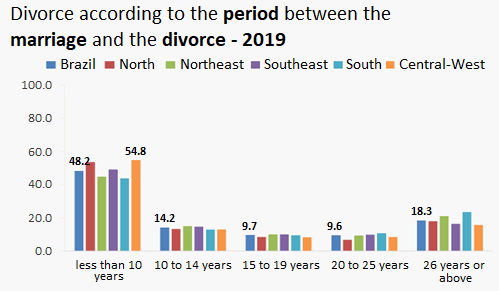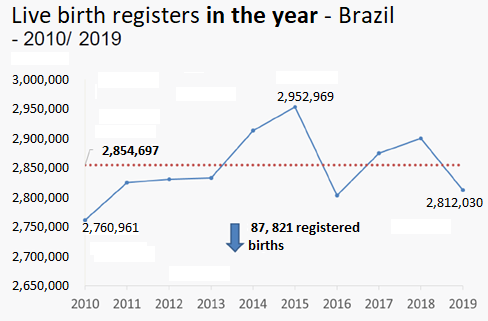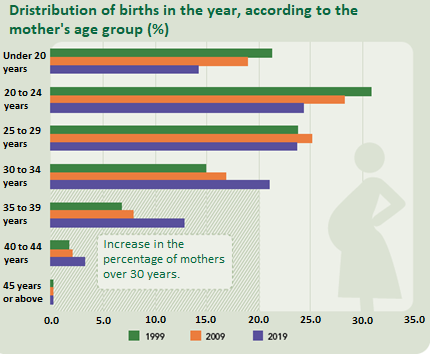Vital Statistics 2019: number of marriage registers decreases 2.7% in relation to 2018
December 09, 2020 10h00 AM | Last Updated: December 18, 2020 11h49 AM
The number of marriage registers in Brazil reduced 2.7% between 2018 and 2019 (from 1,053,467 to 1,024,676). This drop has occurred annually since 2016. Of the total marriages registered, 9,056 were between same-sex persons. After increasing 61.7% between 2017 and 2018, this type of marriage declined 4.9% between 2018 and 2019.
Among the regions, the biggest drop (4.0%) in the total number of marriages registered in 2019 was in the Southeast and the smallest one (0.3%), in the North.
On the other hand, divorces also dropped (0.5%), changing from 385,246 in 2018 to 383,286 in 2019. Nevertheless, marriages are lasting less than ten years ago. In 2009, the average time between the marriage date and the divorce date was 17.5 years and, in 2019, this average fell to 13.8 years.
After rising for two years, births dropped 3.1% between 2018 and 2019. Of the 2.89 million birth registers in 2019, 2.81 million were related to children born and registered in 2019 and nearly 3% (76,188) corresponded to persons born in previous years or with birth year ignored.
In 1999, more than 30% of the births were from mothers aged between 20 and 24 years. In 2019, the share of the group between 20 and 24 years (24.5%) decreased and got closer to the groups between 25 and 29 years (23.8%) and between 30 and 34 years (21.1%). Births whose mothers had 30 years of age and over in 2019 accounted for 37.4% of the total births occurred in Brazil in 2019, being that share only 23.7% in 1999.
The volume of deaths over the last 11 years increased 24.2%, changing from 1,055,672 in 2008 to 1,314,103 in 2019. Mortality decreased in the initial ages, producing an increment in the number of deaths in older ages, which showed a high mortality. The biggest declines for both sexes were recorded in the groups aged between 5 and 9 years (31.9%) and between 10 and 14 years (26.7%).
In 2019, a male individual aged 20 years had nearly 9 times and half more chance of not completing 25 years than a female individual. In 1988, 31 years before, this figure was 7.3, which configured an increase of 30.1% in the period. In this age group, men had much more probability of dying from non-natural causes than women.
As of 2019, the IBGE adopted a new methodology to calculate the under-registration of births and deaths, not comparable with the previous methodology. In 2018, the estimate of under-registrations of births was 2.37%, whereas the under-registration of deaths stayed at 4.0%.
This information comes from Vital Statistics, which investigate birth, marriage, death and fetal death registrations reported by Civil Registry Offices, as well as divorces reported by Family Courts, Forums, Civil Courts and Notary Public Offices in the entire country.
Number of marriages falls 2.7% between 2018 and 2019
Brazilians are marrying less and less. In 2019, 1,024,676 civil marriages were registered, which represented a reduction of 2.7% over the previous year. Of this total, 9,056 were between same-sex persons.
The number of marriages registered in civil registry offices retreated in all the regions, more in the Southeast (-4.0%) and less in the North (-0.3%).
After the extraordinary rise reported last year (61.7%), civil marriages between same-sex persons dropped 4.9% between 2018 (9,520) and 2019 (9,056), though they remained quite above the figure reported in 2017 (5,887). Marriages between female partners represented 59.1% of the records with this marital arrangement in 2019.
Central-West (-13.1%) and South (-12.8%) were the regions with the most intense drops in the number of marriages between same-sex persons. Only the North posted an increase (6.5%) in the number of such unions.
In Brazil, for each thousand inhabitants at marrying age, 6.2 persons legally married in 2019. And the difference of the average ages of the partners in marriages between single persons of different sexes was nearly 3 years: men married, on average, at 31 years and women, at 28 years.
Number of divorces decreases 0.5% between 2018 and 2019
The number of divorces (383,286) granted in the first instance or through legal deeds dropped 0.5% in 2019 in relation to 2018 (385,246). As a result, the general divorce rate – percentage of divorces per each thousand persons aged 20 years and over – fell from 2.6% (2018) to 2.5% (2019).
But the length of marriages also decreased in the last decade. In 2019, the average time between the marriage date and the date of the divorce decree or deed was of 13.8 years; in 2009, it had been 17.5 years. Also, 48.2% of the divorces occurred less than 10 years after the marriage.

Nevertheless, the proportion of legal divorces between partners whose families had only minor kids increased: it changed from 40.2% of the total number of divorces in 2009 to 45.9% of them in 2019.
The proportion of divorces with shared custody of the children has been increasing as well. In 2014, this arrangement represented 7.5% of the total number of divorces and, in 2019, it changed to 26.8%. Even so, women prevailed when it comes to children custody, present in 62.4% of the divorces. It is important to highlight that, from Law no. 13,058, of December 22, 2014, onwards, shared custody became the rule in divorces, except if one of the parents relinquishes it or if the judge understands it differently, due to lack of conditions of one of the parents.
Brazilians had less children in 2019
Yet, Brazilians had less children in 2019. After rising for two years, births dropped 3.0% between 2018 and 2019. Of the 2,888,218 million birth registers in 2019, 2,812,030 million were related to children born and registered in 2019 and nearly 3.0% (76,188) corresponded to persons born in previous years or with birth year ignored. In 2019, the number of birth records was the third lowest in ten years, surpassing only those of 2016 and 2010.

The drop in the births occurred in all the regions, and in the Southeast (-4.0%) and Northeast (-3.3%), the drops were bigger than the national average (-3.0%). The drops were less intense in the North (-0.8%), Central-West (-1.8%) and South (-2.4%).
Among the Federation Units, Rio de Janeiro registered the highest proportional drop (-5.4%) of births against 2018, followed by Rio Grande do Norte (-4.7%), Alagoas (-4.7%) and Maranhão (-4.5%).
Proportion of mothers aged 30 years and over is nearly at 40%
The last two decades marked a structural change in the age in which women had kids. In 1999, the birth records whose mothers had less than 30 years were 76.3% of the total, falling to 62.5% in 2019.

In 1999, more than 30% of the births were from mothers aged between 20 and 24 years. In 2019, the share of the group between 20 and 24 years (24.5%) decreased and got closer to the groups between 25 and 29 years (23.8%) and between 30 and 34 years (21.1%).
But the North Region had the highest proportion of young mothers: 28.8% of the birth records in 2019 were children whose mothers were aged between 20 and 24 years and 20.5%, of mothers aged less than 20 years. The proportion of births whose mothers had 30 years and over (27.5%) was lower than the national average (37.4%).
On the other hand, the proportion of births whose mothers were aged 30 years or more surpassed 40%, both in the Southeast (41.8%) and in the South (40.9%).
Under-registration of births falls 1.8 percentage points between 2015 and 2018
The estimate of under-registration of births registered a drop between 2017 (2.6%) and 2018 (2.4%). Therefore, 97.6% of the births occurred in 2018 were registered in the same year or up to the first quarter of 2019. In 2016, the estimate of under-registration of births was 3.2% and, in 2015, 4.2%.
The estimate of under-registration of deaths was 4.0% in 2018, pointing out that 96.0% of the deaths occurred in 2018 were registered in the same year or up to the first quarter of 2019. In 2016, the estimate of under-registration of deaths was 4.4% and, in 2015, 4.9%.
Last year, the IBGE adopted a new methodology to measure under-registration of births and deaths related to the years of 2015, 2016, 2017 and, now, 2018. The new methodology is not comparable with the previous methodology, whose time series was closed in 2014.
61.1% of deaths are of persons aged 65 years and over
Between 2008 and 2019, the volume of deaths annually occurred and registered increased nearly 24.5%, changing from 1,060,365 in 2008 to 1,317,292 in 2019. In the initial ranges, the most intense declines for both sexes were reported in the age groups between 5 and 9 and between 10 and 14 years (31.9% and 26.7%, respectively).
From 55 years onwards, important increases in the total number of deaths recorded occurred due to the aging of the population in Brazil. In the population group aged 85 years and over, the increase in the number of deaths was of 68.3%.
In 1978, when Brazil still had an extremely young population, the deaths of persons aged 65 years and over represented 30.1% of the total; in 2008, more than half of the deaths registered was within this age group (53.7%) and, in 2019, this percentage hit 61.1%.
In contrast, the share of deaths of those under 5 years of age dropped nearly 30 percentage points in the period. In 1978, the deaths of those under 1 year and under 5 years of age represented 26.9% and 32.6% of the total deaths registered, respectively. In 2019, these percentages dropped to 2.3% and 2.7%.
Male over-mortality can reach 9.5 among youngsters
In 2019, male over-mortality by non-natural causes in the group between 20 and 24 years was nearly 9.5. Therefore, the chance of a 20-year old man not completing 25 years was 9 times and half the chance of a woman not completing the same age. In 1988, this figure was 7.3, which configured an increase of 30.1% in the period.
If only the records of deaths by natural causes were considered in 2019, a 20-year old man would have 2.1 times more chance of not completing 25 years than a woman in the same age.
In some Federation Units, the amount of death records due to external causes in the male group between 15 and 24 years decreased significantly between 2008 and 2019. It was the case of Espírito Santo, the Federal District, Paraná, São Paulo, Mato Grosso do Sul, Rondônia and Minas Gerais, with drops above 30.0%.
On the other hand, Amazonas posted an increase of 118.8% in this type of record. The biggest increases occurred in states of the North and Northeast regions.

